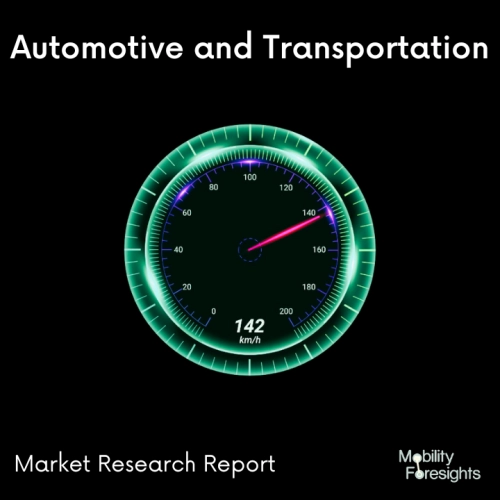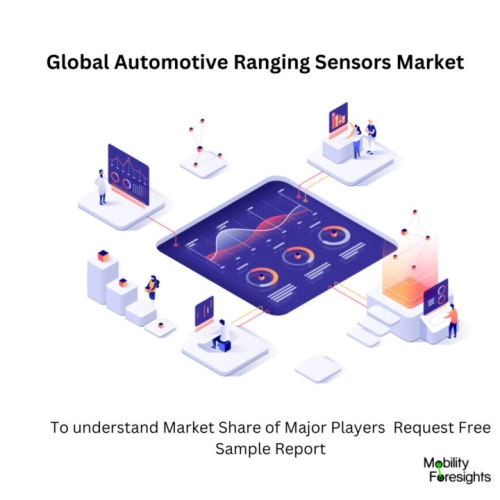
- Get in Touch with Us

Last Updated: Apr 25, 2025 | Study Period: 2023-2030
Ranging sensors are those that do not require physical touch with the thing being detected. They enable a robot to detect an obstruction without actually coming into touch with it. This can reduce entanglement, improve obstacle avoidance (over touch-feedback systems), and perhaps allow software to discern between obstacles of varying forms and sizes.
A sensor may identify barriers from a distance using a variety of approaches. The methods listed below range in complexity and capacity from very simple to highly complicated. The examples below are just meant to provide a broad overview of various popular types of range and proximity sensors as they pertain to robotics. Within each kind, there might be several variations.
To navigate the surroundings safely, fully autonomous vehicles will need sophisticated perception systems that include cameras, RADAR devices, and Light Detection and Ranging (LiDAR) sensors. Because it can scan the vehicle's surroundings and offer a real-time 3D visualization of the surroundings via a point cloud representation, LiDAR is a critical sensor for the future of autonomous driving.
These characteristics can help the autonomous vehicle with a variety of tasks, including object detection and avoidance, precise speed and distance assessments, route navigation, and more. However, detecting the ground plane and road limits is critical for safely navigating the environment, which necessitates extracting information from the point cloud to reliably determine common road borders.
Some automobiles and trucks include headway sensors that monitor the distance between a vehicle and any other vehicles or huge objects in front of it. Adaptive cruise control and/or collision avoidance systems make use of these sensors. There are two main ways to measure distance with radar.
The first method, known as direct propagation, measures the delay associated with receiving a reflected signal, which can be correlated to the distance of the reflecting object as a function of the speed of light and the period, or rather, the time delay in the transmission and reception of the waves. The indirect propagation technique, also known as the Frequency Modulated Continuous Wave (FMCW) approach, is the second method.
A modulated frequency is delivered and received for indirect propagation; the difference in frequency may be utilized to directly calculate the distance as well as the relative speed of the item.
Radar signals are particularly effective in detecting items that substantially reflect electromagnetic radiation (for example, metal objects). Automotive radar systems are good at detecting things that are several centimeters or bigger since they operate at wavelengths of a few millimeters. They are very adept at searching.

The Global Automotive Ranging Sensors Market accounted for $XX Billion in 2022 and is anticipated to reach $XX Billion by 2030, registering a CAGR of XX% from 2023 to 2030.
Ouster, Inc., a leading producer of high-resolution digital lidar sensors for the automotive, industrial, robotics, and smart infrastructure industries, has announced the release of the REV7 OS series scanning sensors, which are driven by the company's next-generation L3 microprocessor.
The all-new OSDome sensor, as well as revised OS0, OS1, and OS2 sensors, provide double the range, improved object identification, better precision and accuracy, and increased dependability.The promise of digital lidar is that, with new processors like L3, the clients will benefit from an ever-improving range of sensors that will follow the exponential performance path year after year.
REV7 is powered by Ouster's next-generation L3 chip, a wholly unique and patented system-on-chip that for the first time delivers back-side-illumination technology, the same image technology that revolutionized the digital camera business, to the high-performance lidar sector. The L3 chip has transistors and maximum computing capability, providing clients with greater digital signal processing and more features than ever before.
The L3 is capable of counting roughly per second and producing thanks to better on-chip processing. The REV7 sensors from Ouster see more than ever before, over longer distances and with higher accuracy, enabling enhanced mapping, more precise obstacle recognition, and safer autonomous operations both indoors and outdoors.
The REV7 sensors have been upgraded to improve their maximum working temperature, lower their power consumption, and double their shock and vibration resistance while preserving the same tiny, light-weight, and power-efficient form factor design as prior generations. Ouster's REV7 sensors are designed for large-scale fleets and use automotive-grade components.
The REV7 sensors have been upgraded to improve their maximum working temperature, lower their power consumption, and double their shock and vibration resistance while preserving the same tiny, light-weight, and power-efficient form factor design as prior generations.
Ouster's REV7 sensors are designed for large-scale fleets and use automotive-grade components.The OSDome has a novel hemispheric field of view for extensive coverage and detection in industrial and smart infrastructure applications. The OSDome, which comes in an unusually compact package, may be put discreetly in the body of a vehicle or on the ceiling of a structure.
Customers may now monitor large zones with a single sensor after eliminating the blind spot on the top of the sensor, simplifying installations and decreasing system complexity.
| 1 | Market Segmentation |
| 2 | Scope of the report |
| 3 | Abbreviations |
| 4 | Research Methodology |
| 5 | Executive Summary |
| 6 | Introduction |
| 7 | Insights from Industry stakeholders |
| 8 | Cost breakdown of Product by sub-components and average profit margin |
| 9 | Disruptive innovation in the Industry |
| 10 | Technology trends in the Industry |
| 11 | Consumer trends in the industry |
| 12 | Recent Production Milestones |
| 13 | Component Manufacturing in US, EU and China |
| 14 | COVID-19 impact on overall market |
| 15 | COVID-19 impact on Production of components |
| 16 | COVID-19 impact on Point of sale |
| 17 | Market Segmentation, Dynamics and Forecast by Geography, 2023-2030 |
| 18 | Market Segmentation, Dynamics and Forecast by Product Type, 2023-2030 |
| 19 | Market Segmentation, Dynamics and Forecast by Application, 2023-2030 |
| 20 | Market Segmentation, Dynamics and Forecast by End use, 2023-2030 |
| 21 | Product installation rate by OEM, 2023 |
| 22 | Incline/Decline in Average B-2-B selling price in past 5 years |
| 23 | Competition from substitute products |
| 24 | Gross margin and average profitability of suppliers |
| 25 | New product development in past 12 months |
| 26 | M&A in past 12 months |
| 27 | Growth strategy of leading players |
| 28 | Market share of vendors, 2023 |
| 29 | Company Profiles |
| 30 | Unmet needs and opportunity for new suppliers |
| 31 | Conclusion |
| 32 | Appendix |